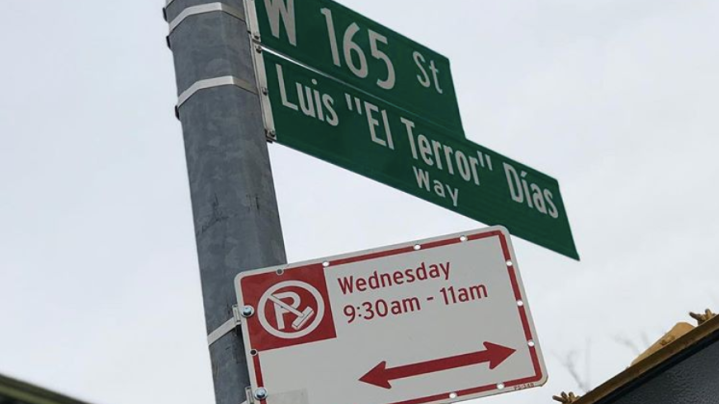Luis Días, Father of Dominican Rock, Honored With a Street in Washington Heights

Courtesy of Different Fitness
On Saturday, December 8, a street in Washington Heights was renamed after Luis “El Terror” Días to mark the anniversary of his death. Días, who is known as the father of Dominican rock, is considered one of the biggest influencers and purveyors of both traditional and alternative styles of the genre in the Dominican Republic. A sign with his name now stands on the corner of 165th Street and Amsterdam Avenue.
The unveiling was commemorated the way Dominicans know best – with an evening of celebration and live music, storytelling, and a sense of nostalgia, as history was not only made but also remembered. The event took place at Word Up Community Bookshop, which is located on the same intersection as the renamed street.
In the 70s and 80s, Días created a sound that was unprecedented in the Dominican Republic. He fused disparate instruments and styles, pioneering polyrhythms by, for example, playing an electric guitar on a merengue track. A student of Dominican folklore, Días blended traditional genres like bachata, salves, and more with reggae, jazz and beyond in his repertoire.
“Even the professional Dominican musicians would be confused about that and say ‘What? I can’t play this,’ and he just really shook things up,” said his partner Laura Sklar during the presentation. “He considered himself un marginado — on the margins, both culturally, and in class. And it’s all in his music.”
Even if you’re not Dominican or don’t follow Dominican music, there’s one particular hook he created that speaks to his legacy beyond the shared island. You might be familiar with the refrain “Baila en la calle de noche, baila en la calle de día” from Shakira’s “Hips Don’t Lie.” Días wrote the same lyric for his 1984 Dominican carnival song and sued the Colombian pop star in 2006.
The song has become an anthem in the month of February, when traditional music is celebrated throughout the country. That it reached a global audience thanks to a non-Dominican artist emphasizes a trend we still see to this day – the erasure of black people from the music they create.
Visual artist Reynaldo García Pantaleón organized the event and suggested the street be renamed in Días’ honor. After several people gave speeches dedicated to Días in the blistering cold, Pantaleón initiated a call-and-response chant right before the unveiling, firmly in the spirit of Días’ work.
“Bomba para Luis Días, para el terror en la 165 de Nueva York,” he sang, as the crowd echoed “Bomba e, Bomba e,” with drums and other Afro-indigenous and traditional roots instruments.
With his music, Días also paved the way for a new generation of artists who are fusing folkloric Dominican genres with contemporary styles. Kaila and Jafé Paulino, two young Dominican musicians living in NYC, grew up listening to him and were present at the event. Local groups played some of his popular songs, including a rendition of “Liborio,” which replaced the lines “Liborio vive” with “Luis Días vive.” Other musicians present included the roots music group KumbaCarey, poet Dió-genes Abréu, and others who collaborated with him like guitarist Lliam Greguez.
As the threat of gentrification looms and the fight to keep the neighborhood Dominican and immigrant persists, the street’s renaming is both a recognition of El Terror and a reminder of the origin of the sounds coming out of people’s windows and car speakers.
“I think he would be really happy that you’re celebrating his life with music because that’s really what he would want you to look to,” said Sklar. “Beyond his personality and the sign, he’d want you to really be into the music.”
Check out photos and video of the unveiling below: